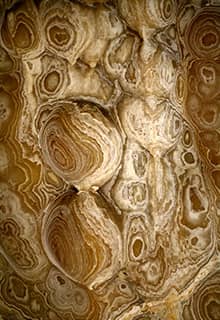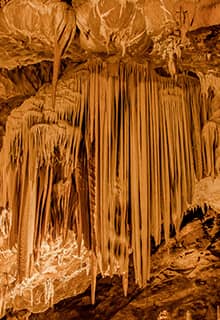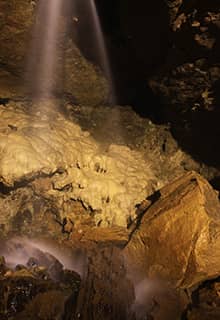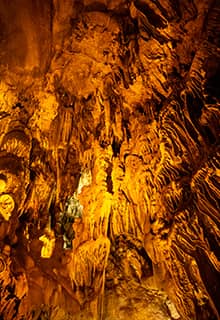

caves Black Sea
Türkiye
Çal Cave, Trabzon
Located 1,050 m above sea level, 5 km southwest of the district of Düzköy in Trabzon Province, Çal Cave is one of the longest caves in the world. Its accessible area is approximately 8 km. A small stream flows inside it and there is a historical castle above it.
Çal Cave has an underground water channel. Although the entrance of the cave is wide, the width decreases to one meter after a certain distance. Ceiling heights vary greatly from a few meters to 25-30 meters depending on the fracture systems.
It is believed that Çal Cave was formed over eight million years ago and that it reached its present shape in two stages. In the first stage, water leaking from the surface dissolved the limestone, creating an underground water channel. In the second phase, the water gradually decreased, and the development of the cave ceased.
Ballıca Cave, Tokat
Listed on UNESCO’s World Heritage Tentative List, the Ballıca Cave in the Black Sea Province of Tokat, is popular with people seeking natural remedies. The cave is situated in the Ballıca Cave Nature Park.
Located more than 1,000 meters above sea level, the cave is famous for its temperature of 18 degrees Celsius, which remains constant throughout the year.
People who suffer from chronic obstructive pulmonary disease (COPD) and sleep apnea come to the cave early in the morning and spend up to four hours here. It is believed that the moisture and the oxygen levels of the cave are therapeutic.
Mencilis Cave, Karabük
Located 10 km northwest of Safranbolu in the historic and touristic district of Karabük in the Black Sea Province, Mencilis Cave features a 400-meter-long route that is open to the public.
The cave is a multistory structure consisting of active and fossil sections extending horizontally. It measures 6,052 m in length. The cave’s first and second floors have been completed and fossilized, which is evident from the darkening of the stalactites and stalagmites. The underground creek that flows through the bottom layer creates siphons and pools, and a 15-meter-tall waterfall inside the cave.
The cave temperature is 12 degrees Celsius and its relative humidity is around 70-75%.
Ilgarini Cave, Kastamonu
Ilgarini Cave is situated 250 meters below sea level in the Black Sea region of Kastamonu, and is the fourth-deepest cave in the world. To get to the cave itself, visitors must trek along a steep path for approximately two hours. As you descend into Ilgarini Cave, you’ll encounter a truly amazing example of a living cave with stalagmites and stalactites stretching from floor to ceiling, growing and changing as they age.
The total length is 860 m and its depth is 250 m. The cave has two parts: the horizontal part is fossilized, and the vertical part is active. At the entrance, there are water cisterns and ruins of houses from the Roman and Byzantine periods. The cave is believed to be 10 million years old, and inside you will encounter stalagmites and stalactites that are a million years old.
There are sections that are hard to access and are protected as they continue to develop. Equipment is required in the vertical part.
Cehennemağzı Caves, Zonguldak
Located in the district of Ereğli in the city of Zonguldak, Cehennemağzı Caves consist of three caves; the first two were built by humans, and the third is a natural formation.
According to legend, the caves, whose name in Turkish translates as “Hell's Mouth Caves,” are believed to have been used by the hero of Greek mythology Hercules in his journey to the Underworld. Since opening to the public in 2001, the caves have become an attraction to local and foreign tourists alike.
The first cave has two parts. In the first part, there is a floor mosaic with geometric and plant motifs. A small apse was created on the eastern wall of the second part.
The second cave is located on a slope with a height of 10-12 m by the roadside and is known to locals as “Koca Yusuf Cave.” The cave continues for 1.5 km into the mountain. In the 1960s, a rock fell from the cave’s ceiling, blocking the path. As a result, a depth of 350 m can be reached.
The third cave is the largest one, and its floor is covered with water. This cave was used as a water cistern for the other two.
During Byzantine times, a Christian resurrection cult used the caves as a place of worship. The mosaic that is mentioned above dates to this time.
Karaca Cave, Gümüşhane
Located in the province of Gümüşhane in the eastern Black Sea region, Karaca Cave is considered one of the most colorful caves in Türkiye. The cave is situated 17 km from the Gümüşhane city center and is 1,550 meters above sea level.
Karaca Cave is rich in dripstone formations of many different shapes and colors, including stalactites, stalagmites, and travertines. Some of the dripstone pools are very large - particularly those in the inner parts of the cave.
The travertines vary in color from white to dark blue, revealing the presence of high levels of iron and magnesium minerals in the cave waters.
Karaca Cave was known to the locals but was opened to the public in 1996 following scientific research that was conducted between 1983 and 1990.
Other Caves in the Black Sea Region
- Gürcüoluk Cave, Bartın
- İnaltı Cave, Sinop
- Çayırköy Cave, Zonguldak (Requires equipment)
- Kızılelma Cave, Zonguldak (Open only to professionals)








